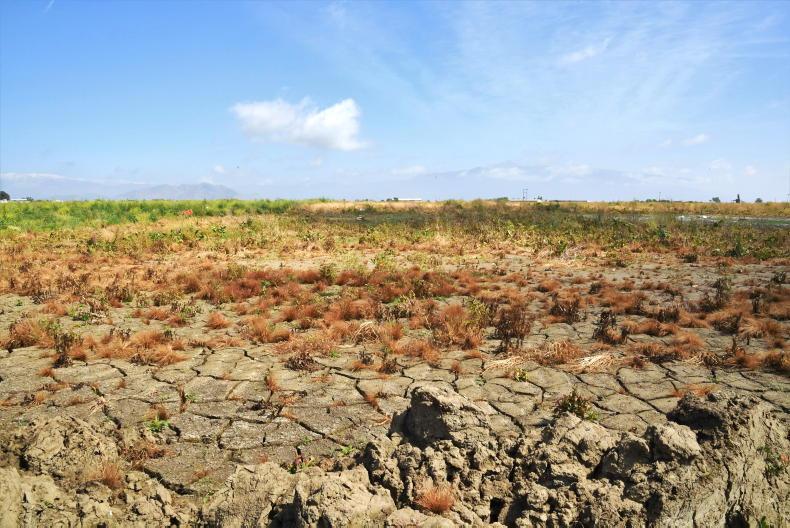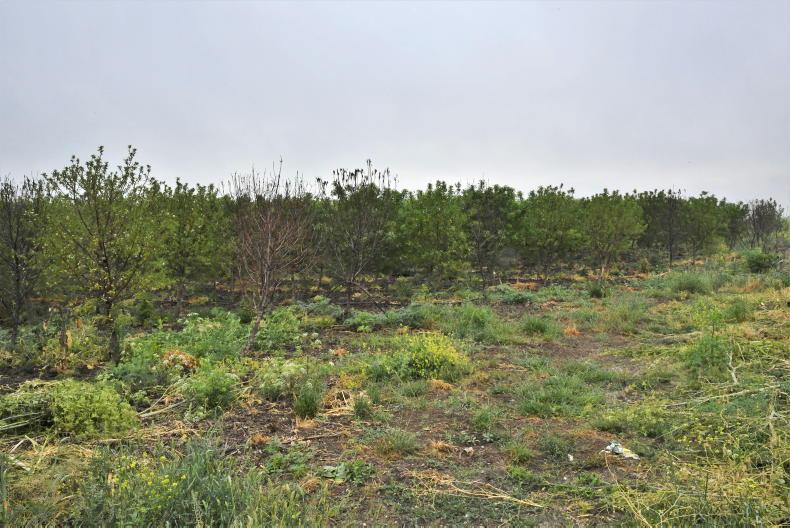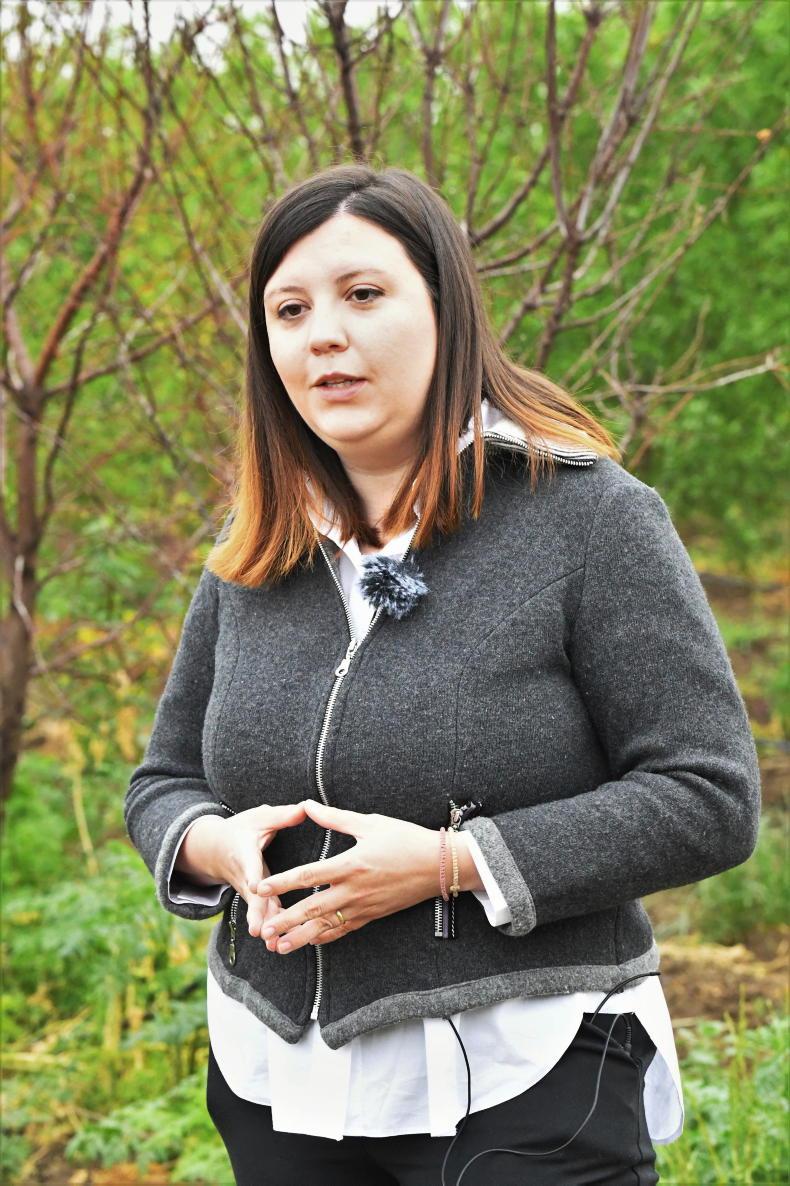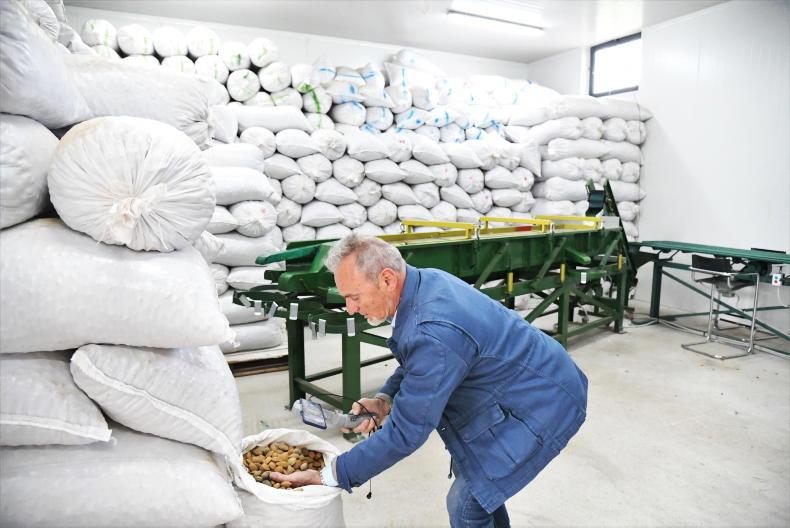Farmers in Greece are struggling to get to grips with intense weather events.
Alongside contending with wildfires in 2023, Greece also experienced devastating flooding.
Storm Daniel hit Thessaly, Greece’s agricultural heartland, in early September last year.
This was the deadliest Mediterranean cyclone recorded in history. From 4 to 7 September 3ft of rain fell.
Some 15 days later, the less severe Storm Elias hit the region, but with the ground saturated and flooding not yet subsided, it was another huge blow to farmers.
Dams burst and rivers broke their banks, destroying farms and washing away farmers’ annual income in one fell swoop.
Seventeen people were killed in the flooding that resulted from Storm Daniel.
In the months since, Greek farmers have tried to pick themselves up and get going again.
For many, it is still uncertain whether their flooded land will produce crops this year and others are still recovering from losing all their livestock.
As a part of a European Commission trip to Greece, the Irish Farmers Journal visited some of these farms to see first-hand the impact.
Georgios Karanikas, cotton farmer
Georgios Karanikas (below) inherited his farm near the city of Larissa in Thessaly from his maternal grandfather.
His main crop is cotton, with the area well-known for producing it. Greece is the only country in Europe to grow cotton and Georgios is proud of his agricultural enterprise.
“Cotton needs a lot of hours of work, but it’s easy because we know it, we know how to produce it. We produce a very good product for the factories. In this area, cotton has been produced for about 100 years. So we want to continue,” he says.

The cotton farm in Greece was completely destroyed by the flooding in September 2023.
In total he farms 35ha, of which 12ha was in cotton, 18ha in grain and 5ha growing legumes. At present, all that is left in a farmable condition is the 5ha in legumes. The rest of the land was destroyed by the September flooding.
When the rain hit, Georgios explains there was nothing they could do except watch as the dam adjacent to his land gave in.
“I couldn’t do anything. When the flood was coming, we just saw it like watching a show in the theatres. We couldn’t do anything.

Georgios Karanikas’ cotton crop and solar panels were destroyed by floods in September 2023. \ © European Union 2024, Cornelia Smet
“The water came here about two or three days after the rain. It wasn’t immediate, it came from villages in the mountains.
“The water came here in the day time and drowned all the fields. It was a very difficult situation. My village flooded also. We had to save some older people from the flood because the water was coming in their houses,” he adds.
Second storm
When the second storm hit, Georgios explains the further havoc it wreaked on his land, but struggles to convey the impact it had on him personally.
“I don’t know how to explain my feelings at that time to you. To see all your work destroyed and you don’t know what you are going to do in the future, for your family and for you also.”

Georgios Karanikas farms 35ha outside the city of Larissa in Thessaly. \ © European Union 2024, Cornelia Smet
As we walk Georgios’ land where he once had cotton, he explains the extent of the damage. His whole crop was washed away and solar panels he had on his land for additional income were also destroyed.
The roadway through his fields was ruined. River clay that was washed there during the flood sticks to our wellies.
At the time of the flooding in September 2023, Georgios’ thoughts went to leaving farming altogether and they still do occasionally.

Georgios Karanikas farms 35ha outside the city of Larissa in Thessaly. \ © European Union 2024, Cornelia Smet
“I have a family. I have a little boy about three years old. For me, my thoughts after the flood were what am I going to do? Am I going to continue to be a farmer?
“I am also an agronomist, I studied at the Agricultural University of Athens. So many thoughts were in my head that probably I will change my job and not be a farmer, be an agronomist or something else. 
Georgios Karanikas’ cotton crop and solar panels were destroyed by floods in September 2023. \ © European Union 2024, Cornelia Smet
“The thoughts didn’t leave my head, they are also here now, because I don’t know when I am going to produce. I want to continue. I like farming,” he says.
Georgios was able to make a comfortable living from growing cotton. On average in Greece, the crop yields 450kg/ha. Price has fluctuated in recent years between 40c/kg and 98c/kg, with recent prices around 65c/kg.
The farmer estimates that the flooding has cost him some €40,000 to date. So far, he has received a €140/strémma (a quarter of an acre approximately) payment from the Greek State via a European Commission fund. A further payment is expected in June.
Eirini Christina Spanouli, almond farmer

Eirini Christina Spanouli produces almonds alongside her father Kostas Spanouli outside the city of Larissa in Greece. \ © European Union 2024, Cornelia Smet
Like cotton, almonds are a foreign concept to Irish agriculture. However, in Greece they have been grown since ancient times.
Eirini Christina Spanouli produces almonds with her father Kostas Spanoulis outside Larissa. However, they weren’t always in nut production. Originally the family were in tillage, primarily growing grain.

Eirini Christina Spanouli. \ © European Union 2024, Cornelia Smet
In 2016, Kostas decided to change enterprise and plant almond orchards instead, as demand for the nut increased globally. He was the first farmer in Greece to apply a high-density planting method, common with fruit trees, to almonds.
This increased yield/ha by one-third compared with conventional planting. The highest yield from this method can reach 364kg/ha.
They are part of a co-op made up of 14 farmers, mainly young farmers, in total farming 12ha of almonds. The Karpologio co-op processes and packages their almonds together in the local village, selling them directly to market.

Eirini Christina Spanouli's cousins have a poultry unit on the farm. \ © European Union 2024, Cornelia Smet
Most of the co-op, including Eirini and Kostas, lost their whole crop in the flood.
The father and daughter duo also have 35 beehives used to pollinate the almonds and 0.4ha covered by solar panels. Not only did they lose all of this in the flood, their cousins also lost 3,000 laying hens and broiler chickens from their poultry unit on the farm.
The poultry graze under and around the solar panels. They slaughter the chickens themselves, selling the meat and eggs at the farmers market in Larissa.
Destruction
At the height of the flooding, the farm was covered in 1.5m of water, Eirini explains.
“They could do nothing but see on the cameras that the chickens would be drowned. They could do nothing to save them. They were totally unable to reach this area.

Eirini and Kostas Spanoulis' almond orchards were destroyed in flooding in September 2023. \ © European Union 2024, Cornelia Smet
“All the area was covered in water. The solar PV was totally damaged and the trees didn’t manage, of course, to survive,” Eirini says.
Many of the trees in the orchard appear scorched and their roots are now rotten. Erini says even the ones still bearing nuts may actually be dead. The almond orchards have been severely affected. Most of the roots have been destroyed and the trees are unable to grow nuts.

The farm was covered in 1.5m at the height of the flooding. \ © European Union 2024, Cornelia Smet
“Even though we opened the ground to let them breathe, the roots became rotten, unable to stand that amount of water. So in one week we saw them getting dry as if they were burnt.
“Even those that seem to be productive, they are diseased. Probably most of them will not survive, because they are unable to absorb the nutrients from the ground and grow almonds,” she adds.
The water flowing through the farm during the flood was so strong, they found marble among the debris washed up.

Eirini and Kostas Spanoulis' almond orchards were destroyed in flooding in September 2023. \ © European Union 2024, Cornelia Smet
“It took from September to December to remove all the material that was brought from a very wide range of places. We are talking about materials brought from up to 10k away. “So it took us a lot of time to remove the material to be able to get to the trees or the poultry unit,” Eirini says.
The Spanoulis lost all their 2023 crop. Eirini and Kostas’ plan is to replant the orchards.
Almond producers in the area have received a flat-rate aid payment. By the end of this month the full extent of damage to the trees will be known and then they will be able to apply to the Greek Government for further compensation.
What next?
What’s next for Thessaly in terms of managing and preventing future flooding?
Farmers we spoke to highlighted that it is a difficult line to balance, as alongside flooding events like this, it is projected that crops like cotton and almonds will require increased irrigation going forward. A Dutch water management company was asked to conduct an assessment in Thessaly following the flooding, which resulted in the suggestion of a complete restructuring of the region.
This included restoring water courses, moving towns and villages and changing farming systems.
Experts have also suggested controlled flooding of farmland in Thessaly.
However, despite uncertainty in the future, farmers’ focus is on getting their feet back on firm ground at present.
Intense weather events have impacted Greek farms since 2023.Three foot of rain fell in four days in September.Farmers are continuing to count the cost of the damage.
The farm was covered in 1.5m at the height of the flooding. \ © European Union 2024, Cornelia Smet

Eirini Christina Spanouli. \ © European Union 2024, Cornelia Smet

Eirini and Kostas Spanouli are part of the Karpologio co-op. \ © European Union 2024, Cornelia Smet

Eirini and Kostas Spanouli are part of the Karpologio co-op. \ © European Union 2024, Cornelia Smet
Read more
Flooding of farmland mooted in Greece
Almost one-third of farms owned by women in Greece
Watch: milking up to 300 organic ewes at the foot of Mount Olympus in Greece
Farmers in Greece are struggling to get to grips with intense weather events.
Alongside contending with wildfires in 2023, Greece also experienced devastating flooding.
Storm Daniel hit Thessaly, Greece’s agricultural heartland, in early September last year.
This was the deadliest Mediterranean cyclone recorded in history. From 4 to 7 September 3ft of rain fell.
Some 15 days later, the less severe Storm Elias hit the region, but with the ground saturated and flooding not yet subsided, it was another huge blow to farmers.
Dams burst and rivers broke their banks, destroying farms and washing away farmers’ annual income in one fell swoop.
Seventeen people were killed in the flooding that resulted from Storm Daniel.
In the months since, Greek farmers have tried to pick themselves up and get going again.
For many, it is still uncertain whether their flooded land will produce crops this year and others are still recovering from losing all their livestock.
As a part of a European Commission trip to Greece, the Irish Farmers Journal visited some of these farms to see first-hand the impact.
Georgios Karanikas, cotton farmer
Georgios Karanikas (below) inherited his farm near the city of Larissa in Thessaly from his maternal grandfather.
His main crop is cotton, with the area well-known for producing it. Greece is the only country in Europe to grow cotton and Georgios is proud of his agricultural enterprise.
“Cotton needs a lot of hours of work, but it’s easy because we know it, we know how to produce it. We produce a very good product for the factories. In this area, cotton has been produced for about 100 years. So we want to continue,” he says.

The cotton farm in Greece was completely destroyed by the flooding in September 2023.
In total he farms 35ha, of which 12ha was in cotton, 18ha in grain and 5ha growing legumes. At present, all that is left in a farmable condition is the 5ha in legumes. The rest of the land was destroyed by the September flooding.
When the rain hit, Georgios explains there was nothing they could do except watch as the dam adjacent to his land gave in.
“I couldn’t do anything. When the flood was coming, we just saw it like watching a show in the theatres. We couldn’t do anything.

Georgios Karanikas’ cotton crop and solar panels were destroyed by floods in September 2023. \ © European Union 2024, Cornelia Smet
“The water came here about two or three days after the rain. It wasn’t immediate, it came from villages in the mountains.
“The water came here in the day time and drowned all the fields. It was a very difficult situation. My village flooded also. We had to save some older people from the flood because the water was coming in their houses,” he adds.
Second storm
When the second storm hit, Georgios explains the further havoc it wreaked on his land, but struggles to convey the impact it had on him personally.
“I don’t know how to explain my feelings at that time to you. To see all your work destroyed and you don’t know what you are going to do in the future, for your family and for you also.”

Georgios Karanikas farms 35ha outside the city of Larissa in Thessaly. \ © European Union 2024, Cornelia Smet
As we walk Georgios’ land where he once had cotton, he explains the extent of the damage. His whole crop was washed away and solar panels he had on his land for additional income were also destroyed.
The roadway through his fields was ruined. River clay that was washed there during the flood sticks to our wellies.
At the time of the flooding in September 2023, Georgios’ thoughts went to leaving farming altogether and they still do occasionally.

Georgios Karanikas farms 35ha outside the city of Larissa in Thessaly. \ © European Union 2024, Cornelia Smet
“I have a family. I have a little boy about three years old. For me, my thoughts after the flood were what am I going to do? Am I going to continue to be a farmer?
“I am also an agronomist, I studied at the Agricultural University of Athens. So many thoughts were in my head that probably I will change my job and not be a farmer, be an agronomist or something else. 
Georgios Karanikas’ cotton crop and solar panels were destroyed by floods in September 2023. \ © European Union 2024, Cornelia Smet
“The thoughts didn’t leave my head, they are also here now, because I don’t know when I am going to produce. I want to continue. I like farming,” he says.
Georgios was able to make a comfortable living from growing cotton. On average in Greece, the crop yields 450kg/ha. Price has fluctuated in recent years between 40c/kg and 98c/kg, with recent prices around 65c/kg.
The farmer estimates that the flooding has cost him some €40,000 to date. So far, he has received a €140/strémma (a quarter of an acre approximately) payment from the Greek State via a European Commission fund. A further payment is expected in June.
Eirini Christina Spanouli, almond farmer

Eirini Christina Spanouli produces almonds alongside her father Kostas Spanouli outside the city of Larissa in Greece. \ © European Union 2024, Cornelia Smet
Like cotton, almonds are a foreign concept to Irish agriculture. However, in Greece they have been grown since ancient times.
Eirini Christina Spanouli produces almonds with her father Kostas Spanoulis outside Larissa. However, they weren’t always in nut production. Originally the family were in tillage, primarily growing grain.

Eirini Christina Spanouli. \ © European Union 2024, Cornelia Smet
In 2016, Kostas decided to change enterprise and plant almond orchards instead, as demand for the nut increased globally. He was the first farmer in Greece to apply a high-density planting method, common with fruit trees, to almonds.
This increased yield/ha by one-third compared with conventional planting. The highest yield from this method can reach 364kg/ha.
They are part of a co-op made up of 14 farmers, mainly young farmers, in total farming 12ha of almonds. The Karpologio co-op processes and packages their almonds together in the local village, selling them directly to market.

Eirini Christina Spanouli's cousins have a poultry unit on the farm. \ © European Union 2024, Cornelia Smet
Most of the co-op, including Eirini and Kostas, lost their whole crop in the flood.
The father and daughter duo also have 35 beehives used to pollinate the almonds and 0.4ha covered by solar panels. Not only did they lose all of this in the flood, their cousins also lost 3,000 laying hens and broiler chickens from their poultry unit on the farm.
The poultry graze under and around the solar panels. They slaughter the chickens themselves, selling the meat and eggs at the farmers market in Larissa.
Destruction
At the height of the flooding, the farm was covered in 1.5m of water, Eirini explains.
“They could do nothing but see on the cameras that the chickens would be drowned. They could do nothing to save them. They were totally unable to reach this area.

Eirini and Kostas Spanoulis' almond orchards were destroyed in flooding in September 2023. \ © European Union 2024, Cornelia Smet
“All the area was covered in water. The solar PV was totally damaged and the trees didn’t manage, of course, to survive,” Eirini says.
Many of the trees in the orchard appear scorched and their roots are now rotten. Erini says even the ones still bearing nuts may actually be dead. The almond orchards have been severely affected. Most of the roots have been destroyed and the trees are unable to grow nuts.

The farm was covered in 1.5m at the height of the flooding. \ © European Union 2024, Cornelia Smet
“Even though we opened the ground to let them breathe, the roots became rotten, unable to stand that amount of water. So in one week we saw them getting dry as if they were burnt.
“Even those that seem to be productive, they are diseased. Probably most of them will not survive, because they are unable to absorb the nutrients from the ground and grow almonds,” she adds.
The water flowing through the farm during the flood was so strong, they found marble among the debris washed up.

Eirini and Kostas Spanoulis' almond orchards were destroyed in flooding in September 2023. \ © European Union 2024, Cornelia Smet
“It took from September to December to remove all the material that was brought from a very wide range of places. We are talking about materials brought from up to 10k away. “So it took us a lot of time to remove the material to be able to get to the trees or the poultry unit,” Eirini says.
The Spanoulis lost all their 2023 crop. Eirini and Kostas’ plan is to replant the orchards.
Almond producers in the area have received a flat-rate aid payment. By the end of this month the full extent of damage to the trees will be known and then they will be able to apply to the Greek Government for further compensation.
What next?
What’s next for Thessaly in terms of managing and preventing future flooding?
Farmers we spoke to highlighted that it is a difficult line to balance, as alongside flooding events like this, it is projected that crops like cotton and almonds will require increased irrigation going forward. A Dutch water management company was asked to conduct an assessment in Thessaly following the flooding, which resulted in the suggestion of a complete restructuring of the region.
This included restoring water courses, moving towns and villages and changing farming systems.
Experts have also suggested controlled flooding of farmland in Thessaly.
However, despite uncertainty in the future, farmers’ focus is on getting their feet back on firm ground at present.
Intense weather events have impacted Greek farms since 2023.Three foot of rain fell in four days in September.Farmers are continuing to count the cost of the damage.
The farm was covered in 1.5m at the height of the flooding. \ © European Union 2024, Cornelia Smet

Eirini Christina Spanouli. \ © European Union 2024, Cornelia Smet

Eirini and Kostas Spanouli are part of the Karpologio co-op. \ © European Union 2024, Cornelia Smet

Eirini and Kostas Spanouli are part of the Karpologio co-op. \ © European Union 2024, Cornelia Smet
Read more
Flooding of farmland mooted in Greece
Almost one-third of farms owned by women in Greece
Watch: milking up to 300 organic ewes at the foot of Mount Olympus in Greece
























SHARING OPTIONS